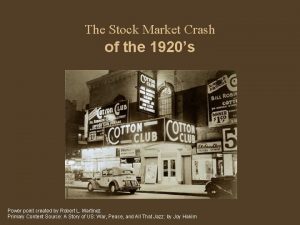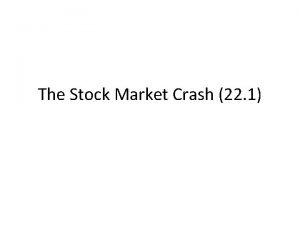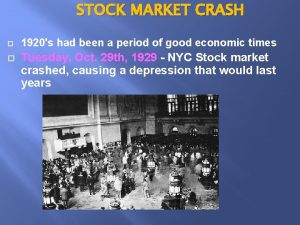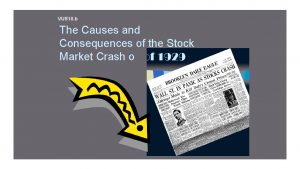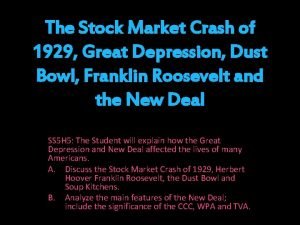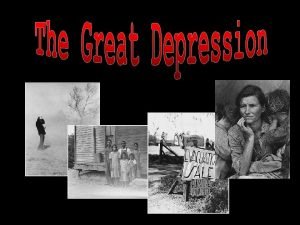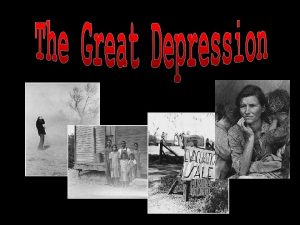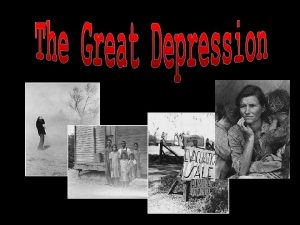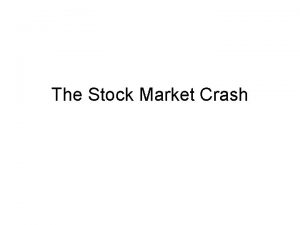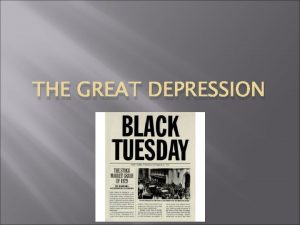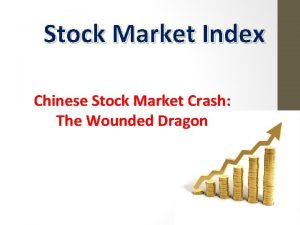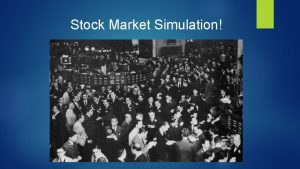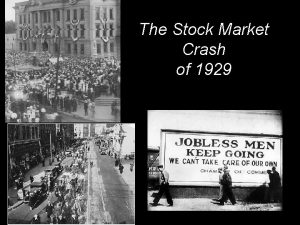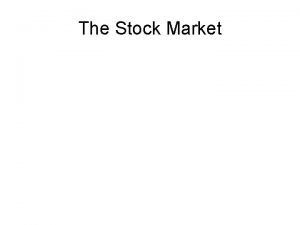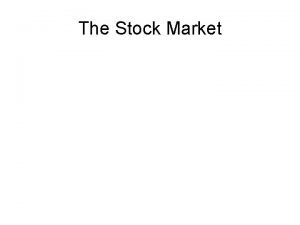The Great Crash The Stock Market Crash of












- Slides: 12

The Great Crash The Stock Market Crash of 1929

Stock Market Soars n Bull market a long period of rising n n n prices in the stock market A prolonged bull market in the late 20 s convinced people to invest in stocks By 1929, 10% of American households owned stocks Investors began to buy on margin (making only a small cash down payment) Margin call stockbroker could demand the investor to repay the loan used to buy on margin at once) Speculation Buyers would bet that the market would continue to climb so they would buy riskier stocks hoping for a large profit

Stock Market Crash n Monday, October 21, 1929 stock market plunged and people began to have to pay back loans used to buy stock n People began to sell their stocks at a frenzied pace to gain back as much money as they could n Thursday, October 24, 1929 the stock market plummeted once again n “Black Thursday”

Stock Market Crash n Tuesday, October 29, 1929 Prices fell again to an all-time low n “Black Tuesday” n Almost 16 million shares of stock were sold n Stock market lost between $1015 billion n By mid-November, stock prices dropped by more than a third n $30 billion was lost (equal to total wages earned by Americans in 1929)

Stock Prices, 1920 -1932


Banks Began to Close n Stock market crash greatly weakened the nation’s banks n By 1929, banks had loaned nearly $6 billion to stock speculators n Banks were also investing depositor’s money in the stock market, hoping for higher returns than by simply loaning money n Banks lost money on the investments with the crash and speculators defaulted on their loans

Banks Began to Close n With heavy losses, banks began to cut back on the loans they made n Less credit available = consumers and businesses being unable to borrow as much money = economy in recession n Some banks were forced to close n Government did not insure bank deposits, so if a bank collapsed, people would lose their savings n Bank failures resulted in a severe loss of confidence in the banking system

Bank Run n News of bank failures worried n n n many Americans Some depositors would take their money out of the bank Bank run many depositors take their money out of a bank at one time Banks only kept a small percentage of depositors money in the actual bank Too many people withdrawing their money often resulted in a bank collapse More than 10% of the nation’s banks (almost 3, 500) had closed by 1932

Number of Failures Bank Failures

Unemployment Increases n With the loss of savings due to the bank crisis, many businesses were forced to make cut backs in their workforce n As Americans were losing their jobs, they began to spend less money in the market n More businesses were forced to close, and more Americans became unemployed n The unemployment rate during the great depression rose to 25%

Persons (millions) Unemployment, 1928 -1932
 Great stock market crash 1929
Great stock market crash 1929 Stock market political cartoon
Stock market political cartoon Stock market crash in 1929
Stock market crash in 1929 Stock market in 1920
Stock market in 1920 Black friday stock market crash
Black friday stock market crash 1929 stock market crash
1929 stock market crash Vus.10b when was the stock market crash?
Vus.10b when was the stock market crash? Chicago bulls and bears stock market
Chicago bulls and bears stock market Black sunday stock market crash
Black sunday stock market crash Mr betts stock market crash
Mr betts stock market crash Stock market crash
Stock market crash Leader challenger follower
Leader challenger follower Benefits of market segmentation targeting and positioning
Benefits of market segmentation targeting and positioning



